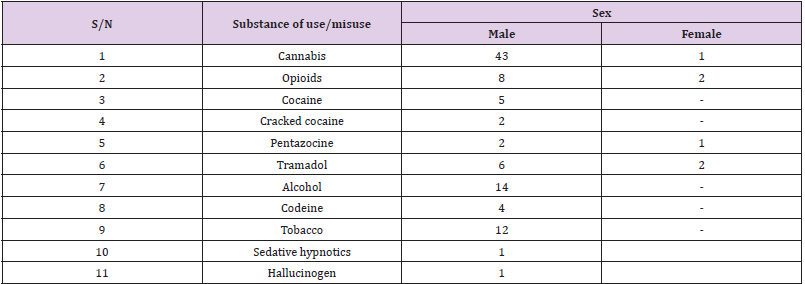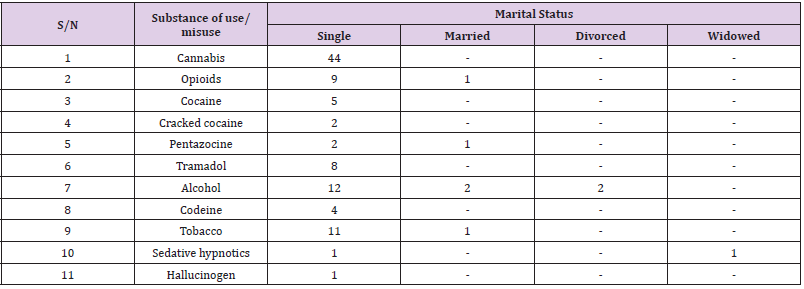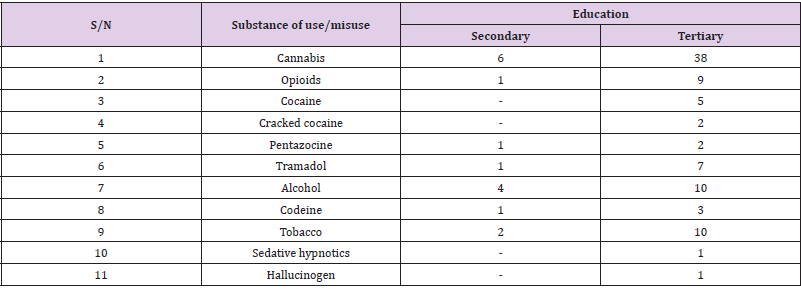Prevalence and Socio-Demographic Correlates of Substance Use Among Patients Attending the drug Unit of the University of Port Harcourt Teaching Hospital
Introduction
According to the World Health Organization [1], substance use
refers to the use of any psychoactive substances or drugs, which
include licit and illicit drugs, other than which are medically
indicated. The United Nations Organizations on Drug Council [2]
stated that substance use is a major public health problem all
over the world. In 2011, it was estimated that 167 to 315 million
people aged 15 to 64 years globally had used an illicit substance
in the preceding year [3]. The estimated global burden of alcohol
and illicit drugs use is 5.4% while tobacco is 3.7% [4]. Psychoactive
substance use poses a threat to the health, social and economic
fabric of families, communities and nations [5]. Drug dependence
is a growing public health problem and consequences of drug dependence cost the community heavily [6]. This habit not only
affects health, education and occupational career, but it also incurs
a huge financial and social burden on the society.
A national survey of substance use conducted among 10,609
Nigerians aged 15-64 years in the six geopolitical zones of the
country recorded a lifetime prevalence of 39% for alcohol, 6.6% for
cannabis and 12.2% for cigarettes [7]. In Nigeria, the most common
types of used substances include stimulants and amphetamines
such as caffeine, tobacco, nicotine, ephedrine; hallucinogens such
as marijuana and narcotics such as heroine and codeine. Others
include alcohol and sedatives [8]. These substances are largely used
due to the belief that they relieve stress and anxiety, and some of
them induce sleep, ease tension, cause relaxation or help users to
forget their problems. The consequences of their abuse could result
in physical dependence [8].
The United Nations Organizations on Drug Council [2]
submitted that prevalence of any drug use in Nigeria is estimated
at 14.4 per cent or 14.3 million people aged between 15 and 64
years; a situation which implies that the extent of drug use in
Nigeria is comparatively high when compared with the 2016 global
annual prevalence of any drug use of 5.6 per cent among the adult
population. Accordingly, one in seven persons aged 15-64 years in
Nigeria had used a drug (other than tobacco and alcohol) in the
past year [2]. The social consequences of drug use are also evident
in Nigeria. Some of which include disruption in family lives, loss in
productivity and legal problems as a consequence of drug use in
their communities. Also, some individuals in the general population
had experienced negative consequences due to other peoples’ drug
use in their families, workplace and communities [5].
Despite the highly reported consequences of substance use, in
different parts of the world including Nigeria, a good number of
individuals’ reports being addicted to specific drugs and presents
at healthcare facilities for medical assistance [4]. In fact, in
University of Port Harcourt Teaching Hospital, Rivers State Nigeria,
some people who have willingly presented themselves for clinical
counseling are currently on drug rehabilitation. Nonetheless, there
is dearth of evidence on the prevalence of substance use disorders
in Nigerian communities, a situation which justifies the need for
this study on the prevalence and socio-demographic correlates of
substance use disorders among individuals on drug rehabilitation
in University of Port Harcourt Teaching Hospital.
Methodology (Materials and Method)
Study Design
Descriptive retrospective design was used in this study.
Study Subjects
The target population consisted of all adult males and females
on drug rehabilitation in University of Port Harcourt Teaching. Only
subjects who been on drug rehabilitation for a minimum period
of six months and were willing to participate were included in the
study. The study was conducted from January 2018 to February
2020. A sample size of 104 subjects was selected using the purposive
sampling technique. Sample size determination was done using
sample size determination formula by Cochran as shown below:
N= Z2P (1-P)/d2
Where N= Sample size
P= Prevalence of drug use = (6.6%) = [0.066] [7].
d= Sampling error that can be tolerated (0.05)
Z= Level of Significance
N= 1.962 0.066(1-0.066)/0.0025
= 0.2368115904 (0.856)/0.0025
=94.725
=94.7
10% non-respondent= 94.7 of 10% =9.47
N=94.7+9.47=104.17
Data Collection
The Nigerian Epidemiological Network on Drug use for drug patients who attended UPTH treatment facility from January 2018 to February 2020 were retrieved and used in the study following ethical clearance.
Data Analysis
Analysis of data was done using the Statistical Package for Social Sciences (SPSS) software version 20.
Results
Table 1 shows that majority of the respondents were males,
94.2%, had tertiary education, 75.0% and were single, 89.4%.
Table 2 shows that sex of individuals influences their substance
use behaviour, as majority of the respondents that uses substances/
drugs were males (P<0.05).
Table 3 shows that marital status of individuals influences their
substance use behaviour, as majority of the respondents that uses
substances/drugs were singles (P<0.05).
Table 4 shows that educational status of individuals influence
their substance use behaviour, as majority of the respondents that
uses substances/drugs had tertiary education (P<0.05).
Table 5 shows the prevalence of substance use disorders
among individuals on drug rehabilitation in University of Port
Harcourt Teaching Hospital. Out of the 104 respondents, 42.3%
use cannabis, 13.5% consume alcohol, 11.5% use tobacco, 9.62%
use opioids, 7.69% use Tramadol, 4.81% use cocaine, 3.85% use
codeine, 2.88% use Pentazocine,1.98% use cracked cocaine, while
0.96% use sedative hypnotics and hallucinogens.
Table 2: Sex of Subjects and Use of Substances among Individuals on Drug Rehabilitation in University of Port Harcourt Teaching Hospital (n=104).
Table 3: Marital Status of Subjects and Use of Substances among Individuals on Drug Rehabilitation in University of Port Harcourt Teaching Hospital (n=104).
Table 4: Educational Status of Subjects and Use of Substances among Individuals on Drug Rehabilitation in University of Port Harcourt Teaching Hospital (n=104).
Table 5: Prevalence of Substance Use Disorders among Individuals on drug Rehabilitation in University of Port Harcourt Teaching Hospital (N=104).
Discussion
The study findings revealed an increasing prevalence of
substance use. Out of the 104 respondents, 42.3% used cannabis,
13.5% consumed alcohol, 11.5% used tobacco, 9.62% used opioids,
7.69% used Tramadol, 4.81% used cocaine, 3.85% used codeine,
2.88% used Pentazocine, 1.98% used cracked cocaine, while 0.96%
used sedative hypnotics and hallucinogens. These results agree
with the findings of Oshodin [8], Adamson et al. [7], Morello et al.
[9] and Jegede et al. [10]. Generally, cannabis, alcohol and tobacco
appear cheaper and more readily available to the average Nigerian
drug user than the other substances, a situation that explains why
they are more prevalent. This may not be the case in other sub-
Saharan African countries and the rest of the world.
It was also discovered that sex, marital and educational status
of individuals influence their substance use behaviour, as majority
of the subjects were males 98 (94.2%), singles 93 (89.4%), and had
tertiary education 73 (75.0%). These results are in consonance
with the assertion of Okpataku [11]. The married ones were less
likely to use drugs etc. A possible reason for this socio-demographic
correlate could be that males are usually more adventurous than
the female folks! Although this assertion may be considered true to
a large extent, it is actually not absolute as Adolfo et al. [12] in
their
study reported otherwise. They found out that drug use was more
prevalent among women. The possible reason for this difference
could be that of setting and culture. Whereas this present study was
conducted in Port Harcourt, South-South Nigeria, Adolfo et al. [12]
conducted theirs in Spain, Europe. On the other hand, drug use being
more prevalent among singles could be due to the fact that they
generally have more freedom and less restriction in the adventures
of life more than the married, divorced and widowed etc. Also, the
fact that most of the drug users had tertiary education explains the
fact that growth, peer pressure or exposure to a higher degree of
thinking/learning could actually predispose one to certain habits such
as drug abuse etc. This may actually not be absolute globally as
some other studies have identified substantial drug use among high
school students, dropouts and street hustlers [2].
Conclusion
In conclusion, there is a high prevalence of drug use in the society; cannabis and alcohol are the most substances of use/ misuse. There is a significant relationship between socialdemographic characteristics of individuals and their potential to use substances as sex, marital and educational status of individuals influences the extent to which they use drugs and related items. A substantial proportion of the subjects that use substances/drugs were males’ singles and had tertiary education.
For more
Articles on : https://biomedres01.blogspot.com/







No comments:
Post a Comment
Note: Only a member of this blog may post a comment.